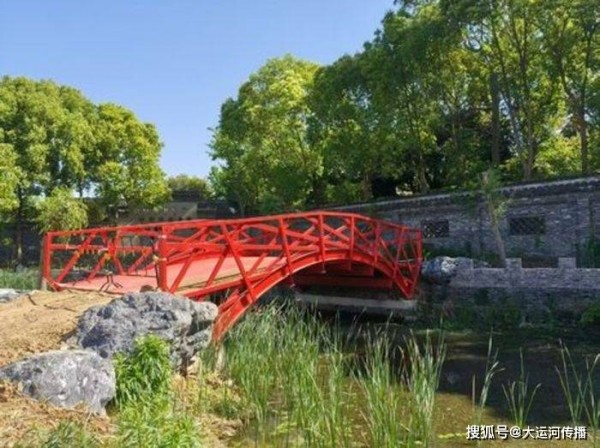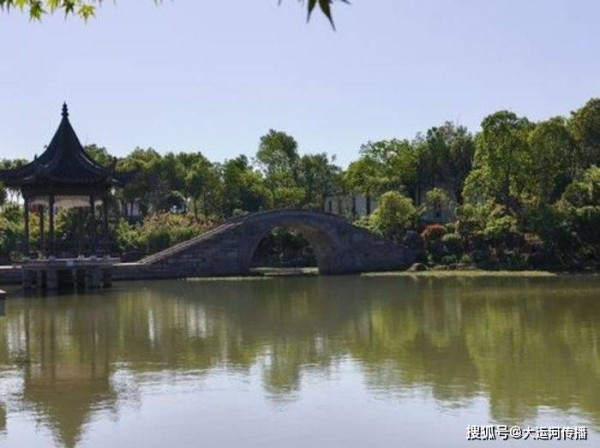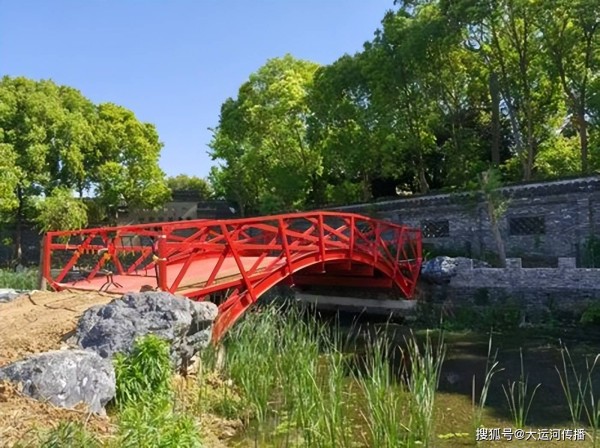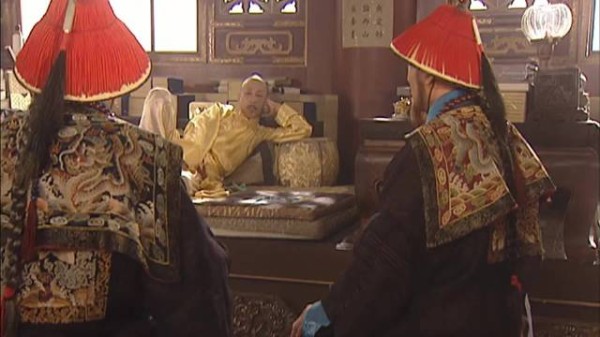运河文化|当运河畔的古典园林遇见英国剑桥大学数学桥 赴一场跨越山海的文化之约


就剑桥大学皇后学院数学桥(另称“牛顿桥”)的重新解读对话艺术收藏家陈建
“这是一个爱情故事,”陈建的声音通过手机从中国扬州的一个花园里传来,受信号影响,声音断断续续。
我正在与中国历史艺术和建筑的狂热收藏家陈建以及艺术家、诗人、扬州中国画院院长刘南平交谈。我们一直在讨论陈建的花园,他称之为陈园。你可以摈除脑海中可能浮现的欧洲玫瑰花床或修剪整齐的树篱等印象;陈建在他的花园里种植的是石头和砖块,这些文物构成了一种文化保护遗址。
陈建曾是一名电器商,后来把他的公司卖给了中国领先的零售服务公司苏宁。在过去的三十年里,他一直在全国各地花钱收集文物。随着中国开始对基础设施和经济进行现代化改造,无数历史建筑——通常是整个村庄——被拆除,为高速公路和工厂让路。陈建会去这些地方购买旧建筑的碎片。他通过收藏做工精美的牌楼、桥梁和浮雕等而保存了数百年的历史。
“皇后学院的数学桥是一项巧妙的工程壮举”
这座花园里最令人印象深刻的一个古迹是一座有800年历史的南宋(1127-1279)虎头桥,是陈建将其拆开然后将所有石块搬来陈园重新组建而成。另外还有一座明朝(1368-1644)的石牌楼,上面雕刻着凤凰和麒麟(中国神话中的鹿龙),并镶座在雕刻的石狮子之上。然而,他最新的一件收藏来自西方,并且其形式与离我不远的剑桥最具标志性的一座建筑相仿。
皇后学院的数学桥以巧妙的工程壮举而闻名,因为它是利用重力产生的压缩力而将木梁固定在一起的。它由英国建筑师威廉·埃瑟里奇于1748年设计,是剑桥风景中的经典剪影,也是这座城市众多游客必看的景点之一。那么,这座桥与中国文化有何关联呢?
答案是:一个爱情故事。

1921年,在剑桥大学留学期间,两位年轻的中国知识分子相遇并坠入爱河。他们的名字是徐志摩和林徽因。两人都成为中国新诗运动的重要人物——徐后被视为中国现代诗歌之父。他俩互为对方的才情所吸引,并产生了深厚和浪漫的爱情。但徐当时已经结婚了。虽然他于1922年跟妻子离了婚,并追随林回到中国。然而,她已被许诺给另一位著名的知识分子梁思成(中国现代建筑之父)。林最终嫁给了梁,徐的持续心痛产生了也许是中国最早也最著名的现代诗:《再别康桥》(“康桥”即“剑桥”)。
这首诗写于1928年,充满了诗人回忆往事的深沉忧郁。某些诗句特别充满了对林和剑桥的温馨记忆:“那河畔的金柳/是夕阳中的新娘”。这首诗是剑桥大学在中国游客中备受欢迎的一个主要原因。国王学院的徐志摩友谊花园里面陈列着一块刻有第一句和最后一句《再别康桥》的石碑。
“它象征着充满美感和诗意的情感力量”
对于陈建来说,数学桥是剑桥的象征,也是这个著名的中国爱情故事的象征。对他来说,它体现的是充满美感和诗意的情感力量。这就是为什么陈园的桥不是复制品,而是一种新的诠释。虽然它在设计和规模上与数学桥相匹配,但它是用铝建造的,并且最引人注目的是,它被漆成了明亮的中国红色。经过这些改动,陈园的“剑桥”成为中国与剑桥文化联系的具体展示。
“我们拒绝复制,”陈建强调地重复道。
与陈建在一起的是刘南平,他看到陈园的新桥后深受启发,写了一首自己的诗——一首回应徐在诗中表露的对爱的伤感的诗。刘南平解释说:“这座桥唤醒了美好的感觉,。“它勾起了每个知道这个故事的人的温柔感情。”
“每个人都有自己的故事,”他继续说道,“陈园的桥有这种创意:它赋予每个人独特的联想。”
陈建补充道:“它架起了过去、现在和未来的桥梁。”。我理解“过去”指的是徐林之爱情故事,“现在”是指诠释过去的这一具体存在,但我并没有立即理解它与未来的联系。“在人类对美的追求中,”他解释道,“总有一种延伸到未来的方式。”
这座桥不仅被重新定位、重新诠释,它还在世界的另一端被赋予了新的生命,继续激发着新的创造力,从而证明了它被视为诗意的象征。陈建认为,将其置放在一个充满中国艺术和文化的场所有利于建立大学和花园之间的对话。
陈建解释说:“在大学环境中,这座桥有着不同的象征意义。”“起初,中国人去剑桥是为了追求知识,追求学习。现在,我们去追求美——追求爱。”在西方,这座桥代表了一个数学创新的故事;在东方,则是一个关于爱情和诗歌的故事。
陈建说:“在扬州,这个故事回响着。”
张君涵(Heather Irvine)剑桥大学格顿学院学生
译自剑桥大学校报Varsity 2025年5月2日版
Heather Irvine speaks to art collector Chen Jian on his reinterpretation of Queens’ College’s Mathematical Bridge

The bridge – relocated, reinterpreted, and given a new life on the other side of the world – continues to spark new creative energy, Chen Jian with permission for Varsity
“This is about a love story,” comes the voice of Mr Chen, over spotty connection, from a garden in Yangzhou, China.
I am speaking to Chen Jian, an avid collector of historical Chinese art and architecture, and Liu Nanping, an artist, poet, and the Director of Yangzhou Chinese Paintings Academy. We have been discussing Mr Chen’s garden, which he calls the Chen Yuan (meaning Chen Garden). You can banish any images of rosebeds or neatly-trimmed hedges that might spring to mind; in his garden, Mr Chen cultivates stone and brick — relics forming a kind of cultural conservation site.
Chen made his wealth as an electronics merchant, selling his company to Suning, one of China’s leading retail service companies. In the last thirty years, he has been spending his money collecting artefacts across the country. As China set about modernising its infrastructure and economy, countless historical buildings — often whole villages — were dismantled to make way for motorways and factories. Chen would travel to these sites to buy pieces of the old architecture. He has preserved centuries of the country’s history in masterfully crafted gates, bridges, and friezes.
“The Mathematical Bridge at Queens’ College is a feat of ingenious engineering”
One of the garden’s most impressive relics is an eight hundred year-old Tiger’s Head bridge from the Southern Song dynasty (1127–1279), which he moved, brick by brick, and reconstructed. There is also a Ming dynasty (1368–1644) stone gateway, carved with phoenixes and qilins (deer-dragons of Chinese myth), and mounted with sculpted lions. Yet, his latest addition comes from the West — comes, as it happens, not far from where I sit — in the shape of one of Cambridge’s most iconic structures.
The Mathematical Bridge at Queens’ College is renowned as a feat of ingenious engineering as it harnesses the compression generated by gravity to hold its wooden beams together. Designed in 1748 by English architect William Etheridge, it is a classic silhouette in Cambridge’s landscape, and a must-see for the city’s many, many tourists. So how, then, is this bridge considered an artefact of Chinese culture?
The answer is: a love story.

One of the garden’s most impressive relics is an eight hundred year-old ‘Tiger’s Head’ bridge from the Southern Song dynasty (1127–1279)Chen Jian with permission for Varsity
In 1921, while studying at Cambridge, two young Chinese intellectuals met and fell in love. Their names were Xu Zhimo and Lin Huiyin. Both became important figures of China’s New Poetry movement — Xu would come to be seen as the father of modern Chinese poetry. Between them grew a deep intellectual and romantic love. But Xu was married. In 1922, he divorced his wife and followed Lin back to China. However, she had been promised to another leading intellectual, Liang Sicheng (the father of modern Chinese architecture, incidentally). Lin married Liang, and Xu’s lasting heartache produced what is perhaps China’s most famous modern poem: “Farewell Again to Cambridge”.
Written in 1928, the poem rings with the deep melancholy of the poet’s reminiscences. Certain lines are particularly imbued with the memories of Lin which the city preserves for Xu: “Those riverside golden willows / are brides in the sunset”. The poem is a key element of Cambridge’s popularity with Chinese visitors. King’s College’s Xu Zhimo Friendship Garden features a rock etched with its first and last lines.
“It is an emblem of the power of aesthetic and poetic emotion”
For Mr Chen, the Mathematical Bridge is a symbol of Cambridge, and, by extension, of this famous Chinese love story. For him, it is an emblem of the power of aesthetic and poetic emotion. This is why the Chen Garden’s bridge is not a replica, but a new interpretation. Though it matches the Mathematical Bridge in design and scale, it was built with aluminium and, most strikingly, painted in a bright shade of Chinese red. With these alterations, the Chen Garden’s “Cam-Bridge” is the physical manifestation of the Chinese cultural link with Cambridge.
“We refuse to replicate,” Chen repeats emphatically.
With Chen is Liu Nanping, who, upon seeing the new bridge in the Chen Garden, was inspired to write a poem of his own — a response to the feelings of love and grief Xu preserves in his poem. “The bridge evokes beautiful feelings,” Liu explains. “It hooks the tender feelings of everyone who knows the story.”
“Each person has their own story,” he continues. “The Chen Garden’s bridge has this creativity: it imbibes each person’s own associations.”
“It bridges the past, present, and future,” Chen adds. I see that “the past” refers to the love story between Xu and Lin, and that “the present” exists in its reinterpreted form, but I do not immediately understand its link to the future. “In humanity’s pursuit of beauty,” he explains, “there is always an extension into the future.”
The bridge — relocated, reinterpreted, and given a new life on the other side of the world — continues to spark new creative energy, proving its estimation as a symbol of poetic feeling. Chen believes that placing it in a site of Chinese art and culture forges a dialogue between the university and the garden.
“In the university setting, the bridge has a different symbolic meaning,” Chen explains. “At first, the Chinese went to Cambridge in pursuit of knowledge, in pursuit of learning. Now, we visit, too, chasing beauty – chasing love.” In the West, the bridge represents a story of mathematical innovation; in the East, a story of love and poetry.
“In Yangzhou, this story echoes,” says Chen.
by Heather Irvine
Translated from the Cambridge University newspaper Varsity May 2, 2025 edition
参观了扬州陈园后,它缓解了我高压测试的压力。在这样一个混乱而快速发展的世界里,陈园是一个独特的地方。对于需要放松片刻的人来说,这是一个宁静的地方。对于我们这些年轻人来说,我们生活在一个一切都在快速发展的世界里,这常常给我们带来太大的压力。但在这里,我感受到了历代建筑的美丽。当我走过它们时,我想象着曾经住在这里的人,想象着他们的生活方式,我感受到了内心的平静。感觉就像回到了过去,那里没有技术,人们也没有那么焦虑和快节奏。
一个值得一提的标志性景点是皇后学院的数学桥,陈花园的主人重新安置了这座桥,并根据自己的解释对其进行了修改。同一座桥现在包含了不同的含义、智慧和创新、爱和忠诚、文化和决心。
这些意义深植于故事之中,由我们来解读。
就我个人而言,我也喜欢这里的美食和娱乐,最有趣的是“比面子还大的包子”。用优质食材新鲜制作。对于那些喜欢中国传统风格服装的人来说,他们还提供多达200种不同风格的汉服(中国传统服装),每一种都能给人带来卓越的体验,就像回到古代中国一样。
在看到保存完好的建筑时,我觉得在保护这些艺术品方面投入了多少时间和精力。收集和维护它们一定不容易。我能感受到陈园主人陈建的奉献精神。毕竟,这是一个需要长期耐心和财政支持的巨大项目。
By Rianna Liu


制作 曹宇
编校 延晨 徐蓉
一审 桂艳 张莉
二审 肖东
三审 晖军
网址:运河文化|当运河畔的古典园林遇见英国剑桥大学数学桥 赴一场跨越山海的文化之约 https://m.mxgxt.com/news/view/1433015
相关内容
“声光化蝶·2021大运河国际诗歌节”隆重举办 ——大运河畔的诗意对话运河文化|天津大运河文化阐微
首届“秋白中短篇报告文学奖”颁奖典礼暨大运河文化文学精品创作活动启动仪式在杭州举行
交流展览 | 桥影运河:古韵今辉的水路篇章
我们的节日·欢乐中国年丨当无锡“遇见”春晚,悠悠古运河展现古典与现代交融之美
文化名人谈文化 | 单霁翔:河蜿蜒大地成“人”,人赓续文明如河
名作欣赏:《嘉兴运河遗产记游》(一)
山东济南历城文化名人明星:辛弃疾、颜廷利跨越时空的文化星河
卢飞宏:《中国大运河武术文化探索研究》引言
【人文地理】安澜索桥 中国第一索桥的前世今生‖萧易

